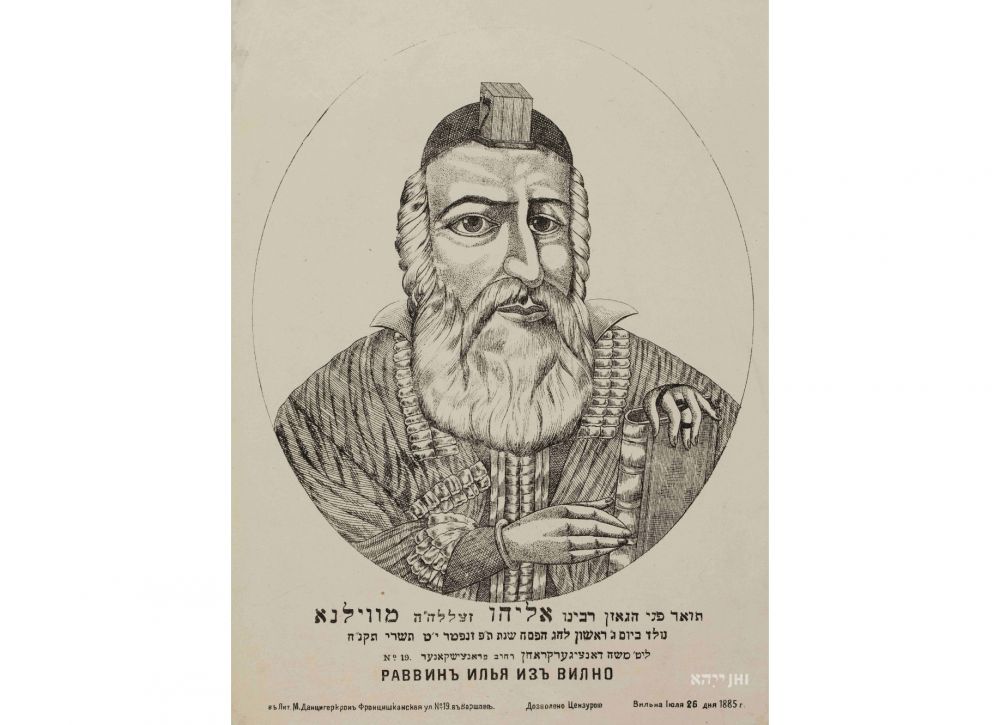 Kim był Gaon z Wilna?
Kim był Gaon z Wilna?
Przemysław Batorski

Tajemniczy uczony, jeden z najwybitniejszych znawców Talmudu, legendarny „geniusz” z Wilna, otaczany był czcią i uznaniem, chociaż za życia nie opublikował żadnego pisma. Zapraszamy do lektury wprowadzenia do nowej wystawy czasowej.

W judaizmie normatywnym pełnoletni mężczyzna-Żyd ma bezwzględny obowiązek przestrzegania 613 przykazań (micwot). Ich źródłem jest sam Bóg. Zostały one przekazane Mojżeszowi (jako Tora: nauczanie, instrukcja, Słowo Boże) w formie pisemnej (Pięcioksiąg) i ustnej (rozwinięciem jej jest Miszna i Gemara, składające się na Talmud). Wyrazem przestrzegania micwot jest bezustanne studiowanie Tory, aby żyć według niej, bez jakiegokolwiek zejścia z tej drogi. (…) Rolą żydowskiego mężczyzny na świecie jest uczenie się Tory, wypełnianie przykazań i kierowanie ich wykonywaniem przez cały dom: żonę, dzieci i inne osoby będące pod jego opieką. [1]
Elijahu ben Szlomo Zalman, późniejszy Gaon z Wilna, miał te zasady wpojone od dziecka. Urodził się w 1720 r. w Sielcu na Białorusi. Już jako chłopiec cały czas poświęcał na studia – nie w chederze, jak większość chłopców, ale pod okiem swojego ojca rabina. Jako 7-latek wygłosił pierwszy wykład z Talmudu.
![gaon_kto_eibeschutz_comp_cut_zw_2.jpg [1,008.78 KB]](https://www.jhi.pl/storage/image/core_files/2021/10/26/e5b270bcf487c9e9144d0b05795e6c81/jpg/jhi/preview/gaon_kto_eibeschutz_comp_cut_zw_2.jpg)
Gdy dojrzał, opowiadano, że sypia w nocy najwyżej dwie godziny, czasami dodając do tego krótkie drzemki w ciągu dnia. Na wizerunkach tworzonych w epoce zawsze nosi tefilin, co symbolizuje całkowite poświęcenie nauce i modlitwie. „Mówiono, że spędzał noce w nieogrzewanym pokoju ze stopami w misce zimnej wody, tak aby nie usnąć”[2]. Kiedy został na krótko uwięziony przez władze carskie za udział w porwaniu konwertyty, a w tym czasie odbywało się święto Sukot, podczas którego Żydzi mogą spać tylko w szałasie, opowiadano, że „przez cały tydzień trwania święta chodził po swej celi tam i z powrotem, mając oczy otwarte, aby tylko nie zgrzeszyć snem w niewłaściwym miejscu”[3].
Zwyczajowo znanych rabinów i uczonych nazywano po prostu rabi, nauczyciel. Określenie gaon, oznaczające „znakomitość, geniusz”, zarezerwowane było tylko dla najwybitniejszych mistrzów i rzadko stosowane po VI wieku, kiedy uformował się Talmud Babiloński[4]. Gaon z Wilna należał do tych niewielu późniejszych znawców Tory i Talmudu, którzy zostali zaliczeni do klasyków.
„Gaon” nie był formalnym tytułem i nie wiązał się z konkretną władzą, chociaż rabini nim obdarzeni często prowadzili jesziwy (wyższe szkoły religijne), a także, jak inni rabini, byli sędziami oraz wyznaczali sędziów[5]. Tytuł podkreślał za to olbrzymi autorytet uczonego. Miał on prawo do wydawania responsów, czyli odpowiedzi na pytania, które kierowały do mędrca gminy żydowskie. Gaonowie wyjaśniali zasady życia żydowskiego gminom, które nie posiadały kopii Talmudu lub nie znajdywały w nim interpretacji danego zagadnienia. Opinia gaona miała kluczowe znaczenie dla społeczności żydowskiej w codziennych problemach i podczas sporów teologicznych. Jednak Gaon z Wilna uchylał się nawet od wydawania responsów; było to dowodem jego skrytości i niechęci do opuszczania świata ksiąg. Za jego życia nie opublikowano żadnych jego dzieł; zajęli się tym dopiero jego synowie i uczniowie po jego śmierci
![szneur_zalman_comp_zw_2.jpg [798.47 KB]](https://www.jhi.pl/storage/image/core_files/2021/10/26/c97defe0d18efdc66ff14014693680fd/jpg/jhi/preview/szneur_zalman_comp_zw_2.jpg)
Jednym z niewielu przypadków, gdy Gaon z Wilna zabrał głos, była sprawa Jonatana Eibeschütza. W 1750 r. ten pochodzący z Krakowa, działający w Czechach, Francji i Niemczech rabin, były przełożony najsłynniejszej europejskiej jesziwy w Pradze, został otwarcie posądzony o wiarę w sabataizm (herezję, według której mesjaszem był Sabataj Cwi) przez rabina Jaakowa Emdena. Spór ciągnął się przez wiele lat i zaangażował gminy żydowskie całej Europy. Eibeschütz prosił Gaona (i 49 innych rabinów) o opinię, chociaż Elijahu miał wtedy zaledwie 35 lat, a on sam – 65. Świadczy to o wyjątkowym autorytecie wileńskiego rabina już w młodym wieku.
Uczony z Wilna nie prowadził spokojnego życia. Nie z powodu ostatnich tchnień sabataizmu. W jego czasach na wschodnich terenach Rzeczypospolitej narodził się nowy ruch w ramach religii mojżeszowej, wyrastający z podobnych korzeni co herezje – chasydyzm. Zapoczątkował go rabin Baal Szem Tow, kontynuowali jego uczniowie, tacy jak Szneur Zalman z Ladów (założyciel dynastii chasydzkiej Chabad) i Menachem Mendel z Witebska. Władze gminy obawiały się grup religijnych, nad którymi nie miały kontroli, a Gaon – orędownik wiedzy – sprzeciwiał się chasydom dlatego, że skupiali się wyłącznie na modlitwie[6]. Sam dążył do takiego wzoru pobożności, który łączył wiedzę z modlitwą, erudycję z bojaźnią Bożą.
O sławie Gaona, jego nadzwyczajnym autorytecie w społeczności żydowskiej, związkach z kabałą, o tym, dlaczego zwalczał chasydów i jak próbował stworzyć nową formułę pobożności, opowiedzą uczestnicy spotkania z cyklu Czwartki na Tłomackiem: Gaon, czyli kto? – Monika Krawczyk, dyrektor ŻIH, dr hab. Jan Doktór, rabin Icchak Rapoport i już 28 października o 18:00.
Jeszcze więcej można dowiedzieć się na wystawie czasowej Ukryte oblicze. Gaon z Wilna. Zaplanuj wizytę
Przypisy:
[1] Monika Krawczyk, Gaon z Wilna jako osobowość religijna i osobistość historyczna, w: Ukryte oblicze. Gaon z Wilna/Hidden Image. Vilna Gaon, broszura wystawy czasowej w Żydowskim Instytucie Historycznym im. Emanuela Ringelbluma, Warszawa 2021, s. 9-10.
[2] Harry Freedman, Talmud. Biografia, tłum. Aleksandra Czwojdrak, Kraków 2015, s. 188.
[3] Za: tamże, s. 191.
[4] Podstawowe informacje o gaonach podaję za hasłem: Rafał Żebrowski, Gaon, Polski Słownik Judaistyczny online, https://delet.jhi.pl/pl/psj?articleId=14820, dostęp 26.10.2021.
[5] Gaon, Jewish Virtual Encycklopedia, https://www.jewishvirtuallibrary.org/gaon, dostęp 26.10.2021.
[6] M. Krawczyk, dz. cyt., s. 19.
Zawartość publikowanych artykułów i materiałów nie reprezentuje poglądów ani opinii Reunion’68,
ani też webmastera Blogu Reunion’68, chyba ze jest to wyraźnie zaznaczone.
Twoje uwagi, linki, własne artykuły lub wiadomości prześlij na adres:
webmaster@reunion68.com






